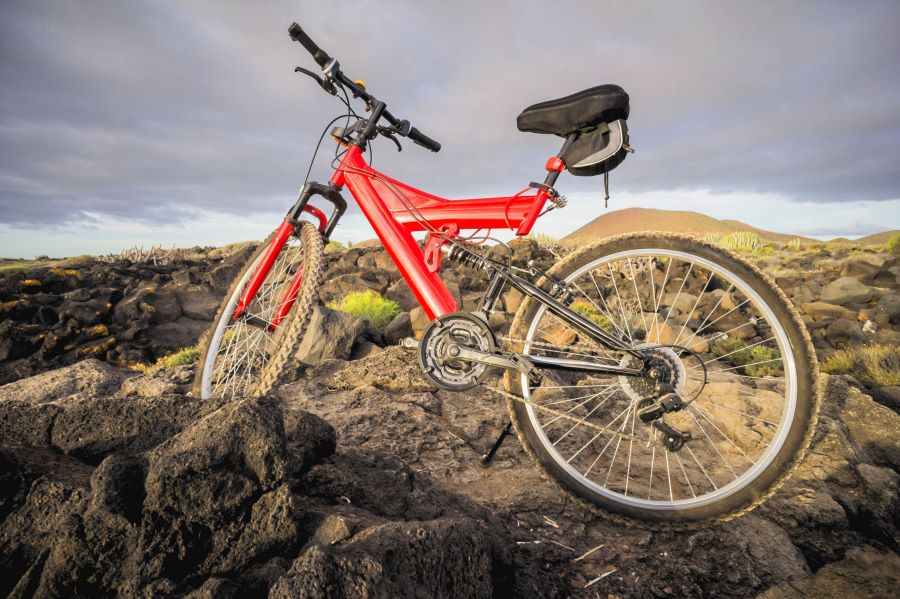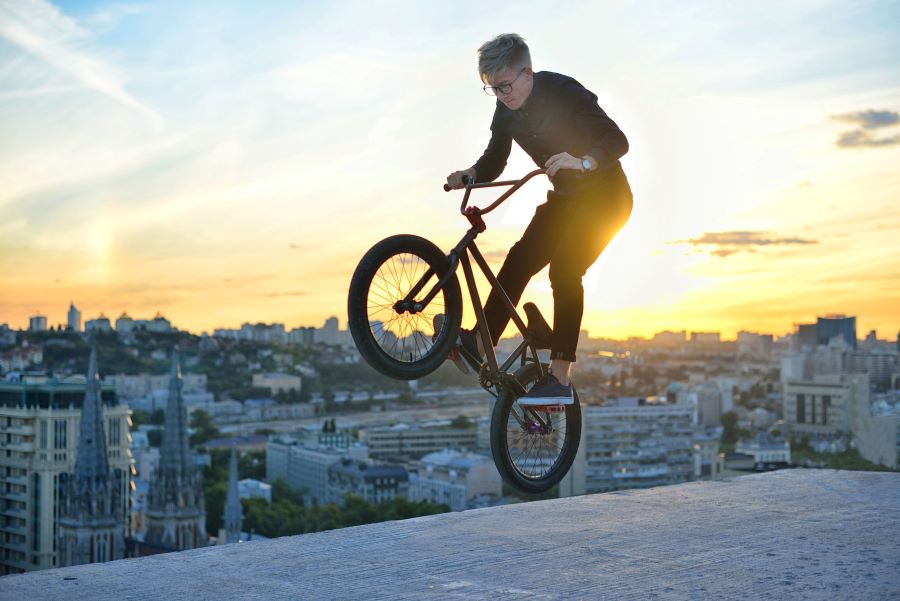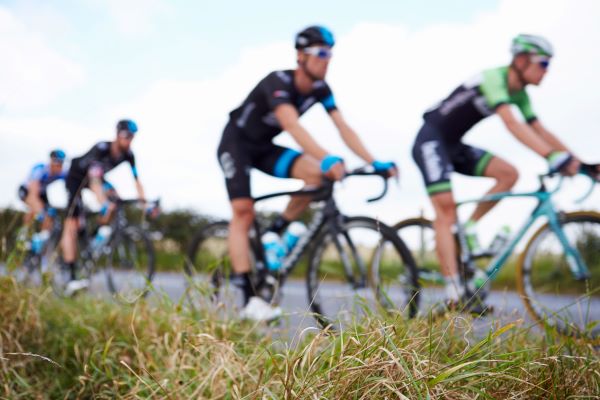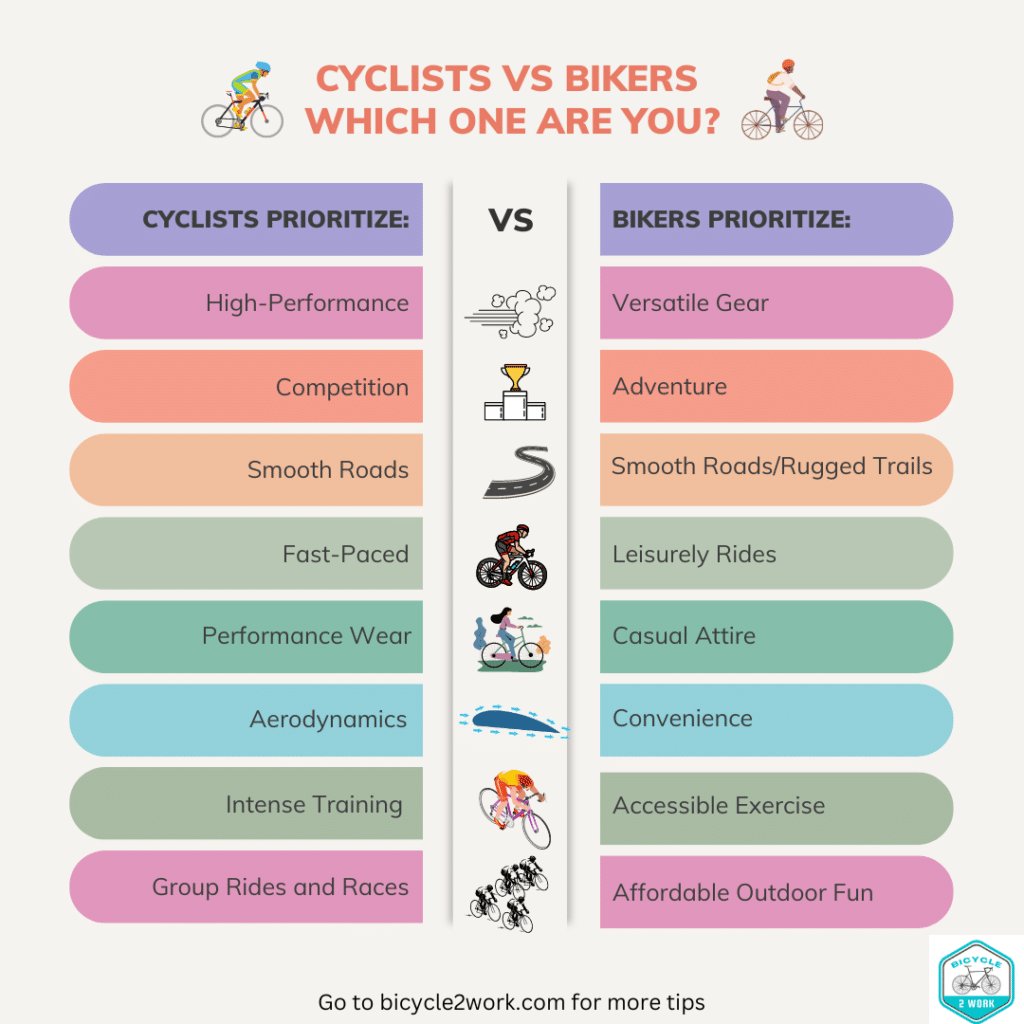This post may contain affiliate links. If you click an affiliate link and make a purchase, I may earn a commission. Also, as an Amazon Associate, I earn from qualifying purchases.--
Do you love the thrill of zipping down the road on two wheels, feeling the wind in your hair, and the rush of adrenaline? Are you a cycling enthusiast who can’t get enough of the open road, or do you prefer the laid-back leisure of a casual bike ride?
Either way, you’ve likely heard the terms “cycling” and “biking” used interchangeably – but did you know that they actually have distinct differences? Most people don’t consider these words to be different, but in the cycling world, it divides enthusiasts into two majorities.
So whether you’re a pro cyclist or a casual rider, here is a guide that won’t leave you confused anymore between cycling and biking. Grab your helmets and read on to find out!
What is Biking?
Picture yourself pedaling along a winding mountain path, your heart pumping and your senses heightened as you navigate through twists and turns, rocks and roots. Or imagine cruising down a scenic trail, feeling the sun on your face and the wind in your hair as you soak in the natural beauty around you.
Biking is not just a means of transportation or exercise; it’s a way of life. It’s a way to connect with nature, challenge yourself, and experience the thrill of adventure.
And the best part is that bikes are accessible to everyone. You don’t need fancy equipment or special skills to get started!

What is Cycling?
Cycling is a form of transportation, recreation, and sport that involves riding a bicycle. It’s a simple yet effective way to get around, stay active, and explore the world around us. From leisurely rides through the countryside to intense training sessions on the open road, cycling offers a wide range of experiences that can be tailored to suit any interest or skill level.
Get ready to pedal your way through some of the most popular forms of cycling! Whether you’re a seasoned pro or just starting, there’s a form of cycling that’s perfect for you. Here are just a few of the most popular types!
- Track cycling is all about speed and power, as riders race around a specially-designed oval track.
- Road cycling is the most common form of cycling, with riders hitting the open road and cruising along paved routes.
- If you’re up for a little off-road action, cyclocross is the perfect form of cycling for you. This challenging sport involves riding over rough terrain, through mud, and over obstacles, making it a true test of both skill and endurance.

The Different Types of Cycles
Let’s take a look at some of the cycling variations that are popular nowadays:
Mountain Bikes
Mountain bikes are designed for riding on rugged terrains, such as rocky trails, steep grades, and loose dirt. These bikes are built to be agile, so they can go uphill or downhill and balance on roots. The sport originated in California in the late 1970s, with bikers using cruiser bicycles to navigate the rugged trails.
Mountain bikes are perfect for those who enjoy off-road adventures and challenging terrain.

Road Bikes
Road bikes are designed for fitness and speed and can tackle steep hills with little effort. These bikes are fast, light, and nimble, making long-distance rides more manageable. They are built to ride on the urban landscape but are versatile enough to handle pavement and dirt.
Road bikes feature narrow tires for reduced rolling resistance, drop handlebars for aerodynamics, and a lightweight frame for speed. They are perfect for those who enjoy fast-paced road cycling and competition.
BMX Bikes
BMX bikes are designed for all terrains and are perfect for riders who want to perform tricks and stunts. These bikes are built to be ridden without using the pedals much, and riders can efficiently perform tricks like 180-degree jumps, turns, and spins. They feature small frames and wheels, wide handlebars for control, and a strong frame to withstand high-impact landings.
BMX bikes are perfect for those who enjoy freestyle riding and BMX racing.

Hybrid/Commuter Bikes
Hybrid/commuter bikes are a combination of road and mountain bikes. They are lighter than other bikes due partly to their versatility, making them convenient for people who need both bikes for different purposes. Hybrid/commuter bikes feature wider tires for added stability, flat handlebars for an upright riding position, and a sturdy frame for durability.
They are perfect for those who enjoy commuting to work or leisurely riding.
Leisure Bikes
Leisure bikes are used for commuting or recreational riding. They feature wide tires, fenders, and an upright design to help riders stay dry. Leisure bikes are built for comfort and are perfect for those who enjoy leisurely rides and a relaxed riding position.
11 Differences that Set Cycling and Biking Apart
High-Performance vs. Versatile Gear
When it comes to equipment, cycling, and biking require different types of gear to ensure optimal performance and safety. Most cyclists frequently take part in races and cycling marathons, so good quality equipment can help you reach the finish line.
From sleek, aerodynamic bikes designed to maximize speed and efficiency, to carbon fiber frames, lightweight wheels, and efficient gearing systems, cyclists need to be mindful of the components that make up their equipment.
On the other hand, biking offers more flexibility and freedom when it comes to riding equipment. It all depends on the terrain you plan on riding, if it’s off-road, you can take a high-performance MTB and if leisurely ride around town, then a simple cruiser bike will be your best bet!
Competition vs. Adventure
For cyclists, riding is often a serious endeavor. Whether it’s for exercise, competition, or transportation, they strive to push their physical limits, achieve personal goals, and constantly improve their performance. They focus on speed, endurance, and technique, and their bikes are often high-performance machines designed for efficiency and speed.
While cyclists focus on speed and efficiency, bikers are all about the adventure and freedom that comes with exploring the outdoors on two wheels. For bikers, it’s all about connecting with nature and enjoying the thrill of the ride. They view biking as a chance to bond with friends and family, and to create lasting memories.
Bikers prefer to explore less-traveled paths and rough terrains, such as scenic routes and off-road trails. They enjoy testing their skills and pushing their limits on their bikes.
Smooth Roads vs. Rugged Trails
The type of terrain you ride on can make or break your cycling or biking experience. Most cyclists have different preferences; if you’re a regular commuter like me, then you might prefer cycling over paved roads.
But those who prefer biking might be more drawn to challenging terrains like mountain trails or dirt roads. There’s something truly exciting about navigating through tight switchbacks and bumpy descents. The challenge and pump of adrenaline that comes with riding in more rugged terrain is truly exhilarating.
So, grab your bike and hit the trails to discover the perfect terrain for your next ride!

Fast-Paced vs. Leisurely Rides
Cyclists are notorious for their need for speed. They are known for their love of speed, often participating in races or time trials to push their physical limits and achieve new personal records.
Most bikers take time in exploring new trails and routes at their own pace, and enjoy the underrated spots they discover along the way. By embracing a slower pace, bikers can fully appreciate the outdoors and enjoy the many benefits of biking in a more relaxed and stress-free way.
Performance Wear vs. Casual Attire
Cyclists often wear specialized clothing designed to enhance their performance and comfort. This includes tight-fitting jerseys that reduce wind resistance, padded shorts that reduce friction and chafing, and shoes that lock onto clipless pedals for maximum power transfer.
For bikers, comfort and practicality are key factors in choosing what to wear on their outdoor adventures. They may opt for more casual attire that is versatile enough for a variety of activities. Clothing that is breathable, flexible, and allows for a full range of motion is often preferred.
This type of attire not only makes for a more comfortable biking experience but also allows bikers to seamlessly transition between different outdoor activities. Whether they’re exploring new trails or simply enjoying a leisurely ride, bikers prioritize comfort and functionality in their clothing choices.

Aerodynamics vs. Protection and Convenience
When it comes to accessories, cyclists, and bikers have their unique needs. Cyclists may use aerodynamic helmets to reduce wind resistance, specialized shoes for maximum power transfer, and clipless pedals that keep their feet securely attached to the pedals.
Bikers often use backpacks or hydration packs to carry essential supplies like water and gear. Once you’re well-equipped with all the essential gear, you will have the confidence to conquer the great outdoors!

Visibility and Traffic Laws vs. Protective Gear and Trail Awareness
Safety should be the top priority for all riders traveling on two wheels, whether it’s cycling or biking. Cyclists take measures such as wearing bright clothing, using lights and reflectors, and following traffic laws to reduce the risk of accidents on roads. By taking these precautions, bikers can enjoy their adventures with peace of mind and stay safe while enjoying their rides.
Safety is always a top priority for bikers, and wearing protective gear like helmets helps to tackle challenging trails with confidence. By taking these precautions, bikers can enjoy their adventures with peace of mind and stay safe while exploring beaten trails. (Source)
Intense Training vs. Accessible Exercise
When it comes to fitness level, both cycling and biking offer different levels of physical challenge. Cycling can be physically demanding but the results are well worth it like endurance and better cardiovascular health. Cyclists often participate in long-distance rides or races that require intense training to achieve their goals.
Let’s be honest, exercise can be boring and it’s hard to find excitement in it. However, biking makes exercise fun and easily accessible for everyone. For example, leisurely rides on flat terrain can provide a low-impact workout that’s easy on the joints, while more intense mountain biking can challenge even the fittest riders.
Group Rides and Races vs. Outdoor Explorers
Both cycling and biking offer opportunities to connect with other riders and form tight-knit communities. Once you start participating in group rides and races, you share the same love (even obsession!) for cycling as the whole community.
Bikers may form communities around their shared love of outdoor adventures, connecting with other enthusiasts through social media and forums.
High-Quality Investment vs. Affordable Outdoor Fun
Another factor to consider when choosing between cycling and biking is the cost. Cyclists often invest in high-quality equipment and gear, which can be quite expensive. Additionally, participating in races or events may require entry fees or travel expenses.
One of the greatest things about biking is that you don’t need to pay to explore off-the-beaten paths, all you need is a good bike and the heart of an adventurer!
Eco-Friendly Transportation vs. Varying Impact on Wildlife
When it comes to the environment, cycling and biking have distinct impacts. Both cycling and biking help to reduce the carbon footprint, which makes it a popular choice for commuters and adventure riders alike!
While it’s an excellent way to explore nature and appreciate its beauty, it can also have negative effects if not done responsibly. Bikers need to be mindful of their surroundings and practice responsible biking to prevent any harm to wildlife and natural areas.
For instance, off-road biking can damage sensitive ecosystems and disturb wildlife habitats if riders do not stick to designated trails. Therefore, bikers need to respect the environment, follow trail rules and avoid causing any harm to the natural surroundings. (Source)
So, are you a cyclist or a biker? Use this infographic to decide and let us know which you are 😊:

Conclusion
In the world of outdoor sports, few activities can rival the exhilaration of cycling and biking. While the two words may seem similar, there are many key differences that set them apart.
From getting in shape and pushing yourself to form tight-knit communities and experiencing the beauty of nature, the possibilities are endless for both cycling and biking. So why not grab your bike, hit the road or trail, and see where the ride takes you?
